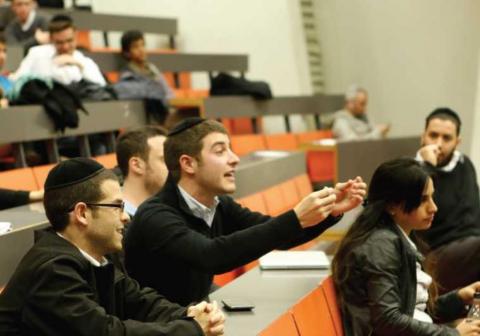Program for integrating ultra-Orthodox students into academia
The education council voted to continue its program for integrating ultra-Orthodox students into academia by a further five years. In the original five-year plan, Haredim were taught almost entirely in separate campuses, but the new plan will pilot segregated classes on existing campuses. In addition, the program will expand the categories of students who can apply for segregated studies: from the ultra-Orthodox to any student declaring themselves “religious Zionist” or “nationalist-Orthodox.”
Some 10 percent of students may come from these alternative backgrounds. Previously, students needed to have spent the final four years of high school – from ninth grade to 12th grade – at an ultra-Orthodox school (as defined by the Education Ministry). The education council also set itself the goal of significantly increasing the number of Haredim studying at university and college. One of the reasons the program has proved contentious is that the studies, for the most part, are segregated to the extent that female lecturers may not teach male students, although male lecturers can teach female students. These restrictions were never previously the norm at Israeli institutions of higher education, and some argue they deviate from the pluralistic, egalitarian nature of academia.
Some education council members argued that the program should be expanded even more, to include graduates of Chabad and Sanz Hasidic schools. Another argument within the council concerned the proposed pilot of segregated classrooms within actual campuses, rather than in separate ones. The main criticism came from the fact that it would introduce segregation into campuses. As for the ban on women teaching male ultra-Orthodox students, the council decided that it does not constitute discrimination against women, and invited any female lecturers who feel otherwise to lodge a complaint.
Segregated ultra-Orthodox higher education is currently available only for B.A. programs. Any ultra-Orthodox student seeking further education has to integrate into the normal framework, but the council says that in its new five-year plan, it will consider opening segregated programs for M.A. studies in nursing and other care professions, as these are highly popular in ultra-Orthodox society. The revised plan will also stress opening new study avenues for the ultra-Orthodox – notably in engineering and the sciences – and in training more ultra-Orthodox teachers to handle core study material.
“The decision to continue running the program was based, among other things, on the impressive achievements of the program for ultra-Orthodox students implemented during the last five years, from 2011 to 2016,” the council wrote in its announcement. “These achievements included an 83 percent jump in the number of ultra-Orthodox students; an 80 percent leap in the number of study tracks for the ultra-Orthodox; and the operation of 19 academic frameworks for the ultra-Orthodox, versus just five before the plan.”
The education council’s announcement completely overlooked various problems that had arisen during the program, or the fact it didn’t meet all of its goals. For example, in the school year 2010-2011, only 5,000 ultra-Orthodox students joined, compared with the goal of 8,500. Another issue glossed over was the high dropout rate: 51 percent among ultra-Orthodox men and 30 percent among Haredi women.
Yarden Skop

